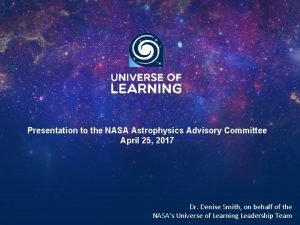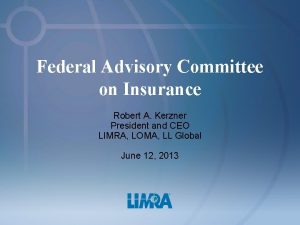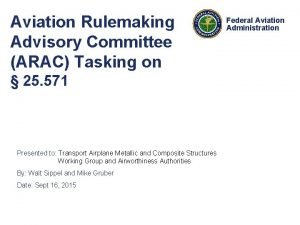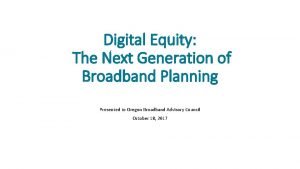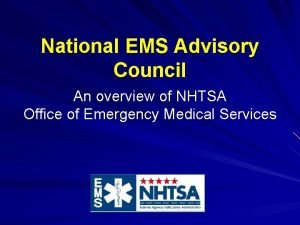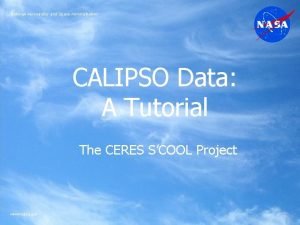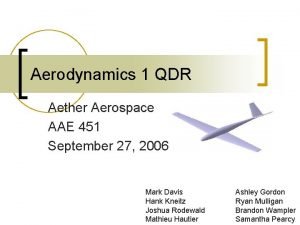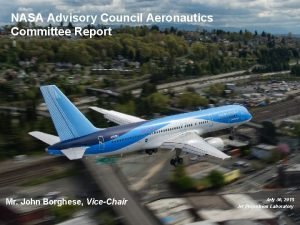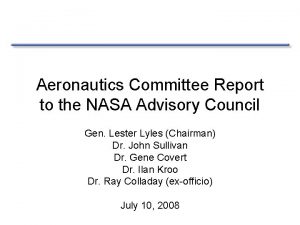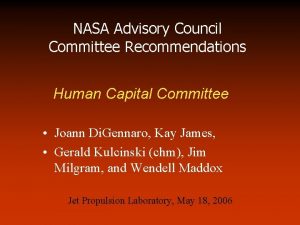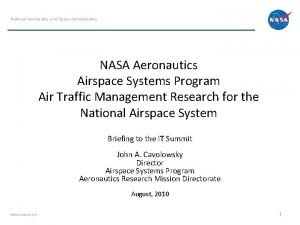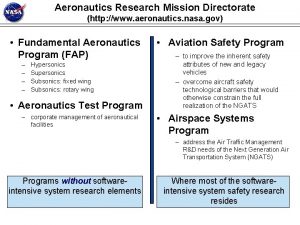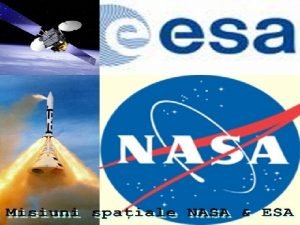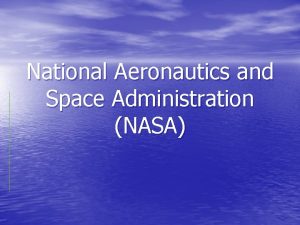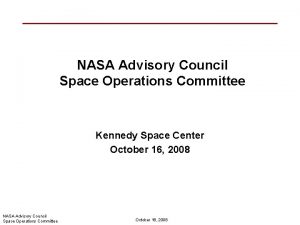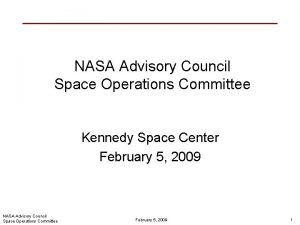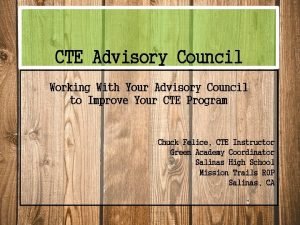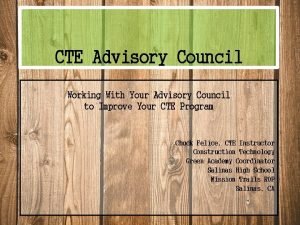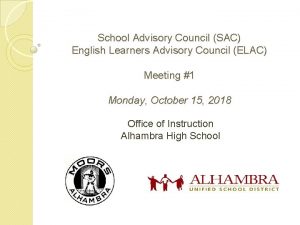Aeronautics Committee Report to the NASA Advisory Council















- Slides: 15

Aeronautics Committee Report to the NASA Advisory Council Gen. Lester Lyles (Chairman) Dr. John Sullivan Dr. Gene Covert Dr. Ilan Kroo Dr. Ray Colladay (ex-officio) October 16, 2008 1

Areas of Interest Explored at Current Meeting • Col. Jeffrey S. Turcotte, Chief of the Air and Weapons Division, Air Force Research Laboratory, Wright Patterson Air Force Base – Status of Agreements Between AFRL and NASA Aeronautics Research – Sense and avoid systems for UAVs and airspace technology for Next. Gen • Dr. Kenneth W. Barker, Chief Engineer, Air Force Research Laboratory, Wright Patterson Air Force Base – Technology Transition process improvements resulting from the USAF Smart Operations for the 21 st Century initiative. • Dr. Jaiwon Shin, Associate Administrator, Aeronautics Research Mission Directorate – Presentation on NASA’s Aeronautics Research and ARMD’s Response to the NAC’s Recommendation for System-Level Work • Dr. Robie Samanta-Roy, Assistant Director for Space and Aeronautics, Office of Science and Technology Policy – Presentation on the Technical Appendix to the National Plan for Aeronautics R&D and Related Infrastructure 2

Status of Agreements AFRL and NASA Aeronautics Research Col Jeff Turcotte AFRL/XPA 14 Oct 2008 3

AFRL Mission Leading the discovery, development, and integration of affordable warfighting technologies for our air, space and cyberspace force. 4

S&T Customers/Stakeholders Special Ops Command Joint Forces Command CSAF & Sec. AF AFMC/CC SAF/AQ Transportation Command AFSPC/CC I-CRRA Capability Shortfalls MAJCOMs Strategic Command DDR&E SAF/US DSB/SAB Wargaming g nin n la P ed ing s a m y-b ram t i l g bi o r a P p Ca and System Program Offices PARNTERSHIPS DARPA Congress ARMY NAVY NASA DOE Balanced S&T Investment 5

Some On-Going Agreements Program Automatic Collision Avoidance Technologies Integrated High Lift and Control Systems High-Speed Wind Tunnel Test of Blended Wing Body Future High Altitude, Long Endurance Vehicles Reduce Fuel Usage Scramjet Engine Tests Software Usage and Validation Directed Energy Effects upon Aircraft Acoustic Signatures Human Factors in Aeronautics JView Visualization for Next. Gen Propulsion and Power Systems Power for Unmanned Aerial Vehicles 6

Summary • AFRL is working with NASA in many areas, as it should • Additional agreements are welcome wherever they make sense – – Unique/underutilized facilities Unique expertise Synergistic benefits where missions overlap Sharing results is a no-brainer in most cases 7

Committee Observation • NASA and the USAF have significant collaborative activities • Much of the collaborations takes place at the working level, where there exists a network of researchers working in related fields 8

Technical Appendix to the National Plan for Aeronautics R&D and Related Infrastructure Robie I. Samanta Roy Assistant Director for Space and Aeronautics Office of Science and Technology Policy NAC Aeronautics Committee Meeting 15 October 2008 9

NAC Aeronautics Committee Observation & Recommendation from April 2008 Meeting • Observation – The National Aeronautics R&D Policy and the follow-on Implementation Plan lay out the roles and responsibilities of participating federal agencies, including NASA, in a collaborative effort to advance U. S. technological leadership in aeronautics. – In the Committee’s view, the NASA Aeronautics program, while currently conducting high quality research, is insufficient in scope to achieve the U. S. leadership objectives implicit in the President’s Aeronautical R&D Policy. • Recommendation – ARMD should plan and develop candidate systems-level research projects of highest priority that should be evaluated and considered by NASA for augmentation in the FY 2010 (and out years) budget request. – These projects should be consistent with the objectives and themes of the National Aeronautical R&D Policy and Implementation Plan, leverage NASA’s unique expertise and competencies, and reflect the priorities of the NRC’s Decadal Survey for aeronautics. 10

NASA’s Aeronautics Research and ARMD’s Response to the NAC’s Recommendation for System-Level Work Overview to the Aeronautics Committee of the NASA Advisory Council (NAC) Dr. Jaiwon Shin ARMD Associate Administrator October 15, 2008 11

ARMD Response Integrated system-level research to address national problem: • Integrate advanced operational concepts and new aircraft and engine technologies to safely increase capacity and reduce fuel burn, noise and emissions. – Demonstrate integration of new aircraft and engine technologies through system level experimentation to simultaneously reduce fuel burn, noise, and emissions – Demonstrate the capability to conduct in-situ field testing of concepts which integrate surface, super-density, separation assurance and/or traffic flow management elements – Understand mitigate safety concerns to fully and safely exploit new capabilities 12

New System-level Research Focus OPERATIONS THEME Based on existing NASA data, investment in terminal procedures has the most benefit to fuel reduction • Continuous climbs and descents (at top 27 airports) • Direct routing/improved rerouting/collaborative TFM • “No-stop” taxi operations (arrivals only at 35 OEP airports) VEHICLE THEME Achieving Significantly Reduced Fuel Burn By Integration of Multiple Technologies 1 = Hybrid wing configuration 2 = 1+ advanced engine and airframe technologies 3 = 2 + embedded engines with BLI inlets 4 = 3 + laminar flow • Reduce noise • Reduce emissions 13

Coordination With Other Efforts FAA: CLEEN JPDO/FAA Demonstrations • NASA is also significantly involved in the technical aspects of this effort • The new activity should compliment any planned JPDO demonstrations, including applications on FAA’s South Florida testbed. • CLEEN focuses on more mature technologies (i. e. N+1) while the new focused activities are intended to explore more advanced (N+2) technologies • The new activities are more closely related to the existing base research portfolio. • The new activity is focused on establishing a more extensive capability to test new operational concepts rather than maturing a few operational concepts that are ready for implementation NASA/FAA Research Transition Teams Industry • ASP System Study NRA – “Integration of Advanced Vehicles Into Next. Gen” • FAP “N+3” System Study NRA – “Advanced Concept Studies for Subsonic and Supersonic Commercial Transports Entering Service in the 2030 -2035 Period” • The new activity will directly support two of the RTTs – Integrated Arrival/Departure/ Surface RTT and Efficient Flow Into Congested Airspace RTT • The improved analysis capability should benefit the future transition of other technologies that are not yet ready for the RTTs. 14

Summary and Committee Observations • ARMD has been very responsive to the Council recommendation • The proposed system-level research will have a major impact on aviation and the environment • This system-level research builds on the progress that has been made in the past two years in the foundational program 15
 Nasa astrophysics advisory committee
Nasa astrophysics advisory committee Federal advisory committee on insurance
Federal advisory committee on insurance Aviation rulemaking advisory committee
Aviation rulemaking advisory committee Yashpal committee upsc
Yashpal committee upsc Trade union advisory committee
Trade union advisory committee Illinois broadband advisory council
Illinois broadband advisory council Source selection advisory council
Source selection advisory council German advisory council on global change
German advisory council on global change President's advisory council on financial capability
President's advisory council on financial capability Oregon broadband advisory council
Oregon broadband advisory council Ciogino sach
Ciogino sach National ems advisory council
National ems advisory council Cadet advisory council
Cadet advisory council Nasa www.nasa.gov
Nasa www.nasa.gov An-naoy
An-naoy Mh32 airfoil
Mh32 airfoil
